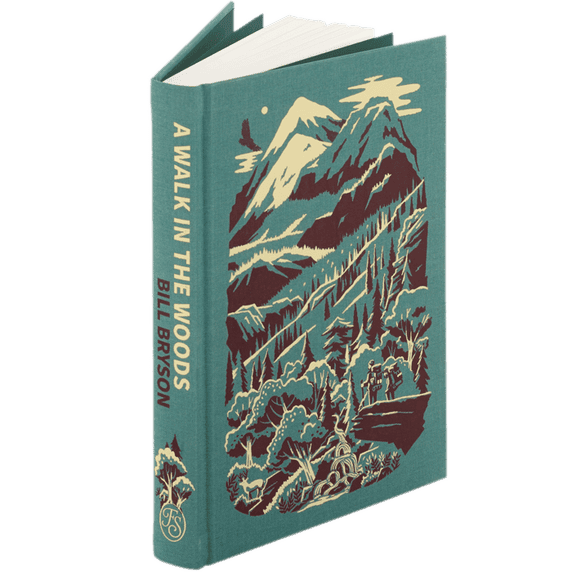
Full of sweat, tears and side-splitting humour, Bill Bryson’s A Walk in the Woods is a page-turning travelogue and this Folio Society edition is the ultimate companion for fans of the author’s inimitable wit.
A Tragicomedy in Two Acts
Illustrated by Quentin Blake
Quentin Blake newly illustrates this spectacular Folio Society edition of Samuel Beckett’s masterpiece, Waiting for Godot.
‘There is no drama more stripped down and essential than Godot.’
- The Guardian
In an edition that showcases the work of two brilliantly dark humourists, Britain’s greatest living illustrator is matched with one of the great plays of the 20th century. Newly commissioned for this extraordinary Folio edition, Quentin Blake depicts the interaction between Estragon, Vladimir and the sparse cast of other characters as they wait for the elusive Godot. Using only shades of purple, his poignant illustrations echo Beckett’s genius for stripping the setting and protagonists bare of all context, while also demonstrating humour and perhaps a glimpse of a latent humanity. Blake has also designed the binding – a symbolic lone tree – while his lettering on the blocked slipcase is at once chaotic and elemental. This remarkable fusion of the work of two formidable creative talents has resulted in a unique collector’s edition that will be enjoyed for generations to come.
Bound in printed and blocked cloth
Set in Fournier with Gill Sans as display
136 pages
24 integrated illustrations printed in 2 colours throughout
Blocked slipcase
11˝ x 7¼˝
Quentin Blake has provided 24 ink drawings in his eponymous style for this new edition of Samuel Beckett’s masterpiece and, in the process, has created one of his very finest sets of illustrations. From the opening illustration which shows Estragon struggling to take his boots off, Blake captures the essence of the play’s dark humour through artwork that is a subtle, comic and appropriately dark parallel to the narrative. Blake was also commissioned to create the binding design and his ethereal, solitary tree is a brilliant summation, instantly recognisable as the bleak set for Waiting for Godot.
‘In an instant all will vanish and we'll be alone once more, in the midst of nothingness.’
- from Waiting for Godot
Originally written and performed in French in 1953, Samuel Beckett translated his play En Attendant Godot into English and it premiered at the Arts Theatre, London in 1955. Famously reviewed as a play in which ‘nothing happens, twice’, Waiting for Godot is one of the great experiments of modern theatre. Beckett’s finest play, it is also one of the great theatrical works of the 20th century. Confusing, often violent and cruel, at times tender, it is a gripping exploration of the desolation and disorder of post-war Europe.
Samuel Beckett (1906–1989) was born in Dublin and educated at Trinity College. He later settled in Paris and lived there for most of his adult life, including during the Nazi Occupation, when he worked for the Resistance. His early writings were deeply influenced by the work of James Joyce; later his works became bleaker in tone, and moved increasingly towards minimalism in both style and content. His novels Molloy, Malone Dies and The Unnamable are often regarded as masterpieces of late modernist fiction. In the theatre, he is best known for Waiting for Godot, Endgame, Happy Days and Krapp’s Last Tape, landmarks of post-war European theatre that explore existentialist ideas in a style that is often desolate, even despairing. Beckett wrote many of his greatest works in French first and later translated them into English. He was awarded the Nobel Prize for Literature in 1969.
Sir Quentin Blake (born 1932) is one of Britain’s leading contemporary illustrators. He has illustrated more than 300 books, specialising in humorous work for children’s fiction, and is perhaps best known for his work on novels by Roald Dahl, as well as books by Michael Rosen and Michael Morpurgo. His first published artwork appeared in Punch when he was a teenager. After studying at the University of Cambridge and the Institute of Education in London, Blake taught for many years at the Royal College of Art and the French lycée in South Kensington. His deep commitment to promoting the art of illustration culminated in the founding of the House of Illustration – now the Quentin Blake Centre for Illustration – in 2014. Blake was Britain’s first Children’s Laureate from 1999 to 2001 and won the Hans Christian Andersen Award in 2002 – the highest recognition in the world for creators of children’s books. Over the course of a long association with the Folio Society that began in 1976, he has illustrated novels as diverse as George Orwell’s Animal Farm and Apuleius’ The Golden Ass.

